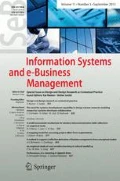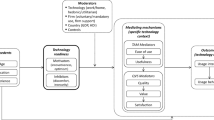Abstract
e-Business organizations must frequently face changes in their systems to stay competitive. However, it is not guaranteed the new systems will be acceptable for the workers. The e-Business Technology Acceptance Model (EBTAM) model is proposed in this paper as a way to study acceptance before actual deployment of a new system. This model takes into account other models reported in the literature, but it is essentially oriented towards small and medium-sized organizations, which usually have limited human and economic resources. The model was used in three companies, and the evaluation instrument was applied at three stages of a system replacement process: (1) before the new system was deployed, in order to capture the independent variables, (2) after 1.5 months of use, and (3) after 9 months of use. Unlike most models reported in the literature, EBTAM shows reasonable predictions about technology acceptance without requiring expert evaluators or many users experienced using the system under evaluation. This fact makes EBTAM easier to implement and use than others evaluation methods, which is particularly important in small organizations given their relatively scarce resources and expertise for this type of evaluations.














Similar content being viewed by others
References
Ajzen I, Fishbein M (1980) Understanding attitudes and predicting social behavior. Prentice-Hall, Englewood Cliffs
Bagozzi RP (2007) The legacy of the technology acceptance model and a proposal for a paradigm shift. J Assoc Inf Syst 8(4):244–254
Bailey JE, Pearson SW (1983) Development of a tool for measuring and analyzing computer user satisfaction. Manag Sci 29(5):530–545
Benbasat I, Barki H (2007) Quo vadis, TAM? J Assoc Inf Syst 8(4):211–218
Borges M, Brézillon P, Pino JA, Pomerol J-C (2007) Dealing with the effects of context mismatch in group work. Decis Support Syst 43(4):1692–1706
Briggs R, Adkins M, Mittleman D, Kruse J, Miller S, Nunamaker J (1998) A technology transition model derived from field investigation of GSS use aboard the U.S.S. CORONADO. J Manag Inf Syst 15(3):151–195
Brown SA, Dennis AR, Venkatesh V (2010) Predicting collaboration technology use: integrating technology adoption and collaboration research. J MIS 27(2):9–53
Chandana J (2010) Understanding S-curve innovation. Improvementandinnovation.com. Retrieved: 15 Nov 2013
Chang S-H, Chou C-H, Yang J-M (2010) The literature review of technology acceptance model: a study of the bibliometric distributions. Proc PACIS 2010:1634–1640
Chong AY-L, Ooi K-B, Li B, Tang SY (2009) Influence of interorganizational relationships on SMEs’ e-Business adoption. Internet Res 19(3):313–331
Dattee B (2007) Challenging the S-curve: patterns of technological substitution. In: Proceedings of the DRUID summer conference on appropriability, proximity, routines and innovation, Copenhagen, Denmark, June 18–20
Davis FD (1989) Perceived usefulness, perceived ease of use, and user acceptance of information technology. MIS Q 13(3):319–340
Davis FD, Bagozzi RP, Warshaw PR (1989) User acceptance of computer technology: a comparison of two theoretical models. Manag Sci 35(8):982–1003
ESA Board for Software Standardization and Control (BSSC)—European Space Agency (1991) ESA software engineering standards. PSS-05-0 Issue 2
Fishbein M, Ajzen I (1975) Belief, attitude, intention, and behavior: an introduction to theory and research. Addison-Wesley, Reading
Grandon E, Pearson JM (2004a) Electronic commerce adoption: an empirical study of small and medium US businesses. Inf Manag 42:197–216
Grandon E, Pearson JM (2004b) E-commerce adoption: perceptions of managers/owners of small and medium sized firms in Chile. Commun AIS 13(8):81–102
Kannenberg A, Saiedian H (2009) Why software requirements traceability remains a challenge. Cross Talk 22(5):14–17
Legris P, Ingham J, Collerette P (2003) Why do people use information technology? A critical review of the technology acceptance model. Inf Manag 40(3):191–204
Leyton D (2013) Extending the TAM model to be used in small and medium-sized organizations. M.Sc. thesis, Computer Science Department, University of Chile
Potter N, Sakry M (2002) Making process improvement work: a concise action guide for software managers and practitioners. Addison-Wesley, Reading
Raymond L (2001) Determinants of web site implementation in small businesses. Internet Res 11(5):411–422
Sharpe ND, de Veaux RD, Vellemanc P (2013) Business statistics and XLSTAT. Pearson Education, Upper Saddle River
Vaidya S, Seetharaman P (2008) Beyond technology acceptance models: a case of collaborative technology. Working paper series 620, Indian Institute of Management Calcutta
Venkatesh V, Bala H (2008) Technology acceptance model 3 and a research agenda on interventions. Decis Sci 39(2):273–312
Venkatesh V, Davis FD (2000) A theoretical extension of the technology acceptance model: four longitudinal field studies. Manag Sci 46(2):186–204
Venkatesh V, Morris MG, Davis GB, Davis FD (2003) User acceptance of information technology: toward a unified view. MIS Q 27(3):425–478
Zhu K, Kraemer KL, Xu S (2006) The process of innovation assimilation by firms in different countries: a technology diffusion perspective on e-Business. Manag Sci 52(10):1557–1576
Author information
Authors and Affiliations
Corresponding author
Rights and permissions
About this article
Cite this article
Leyton, D., Pino, J.A. & Ochoa, S.F. EBTAM: technology acceptance in e-Business environments. Inf Syst E-Bus Manage 13, 211–234 (2015). https://doi.org/10.1007/s10257-014-0255-2
Received:
Revised:
Accepted:
Published:
Issue Date:
DOI: https://doi.org/10.1007/s10257-014-0255-2




